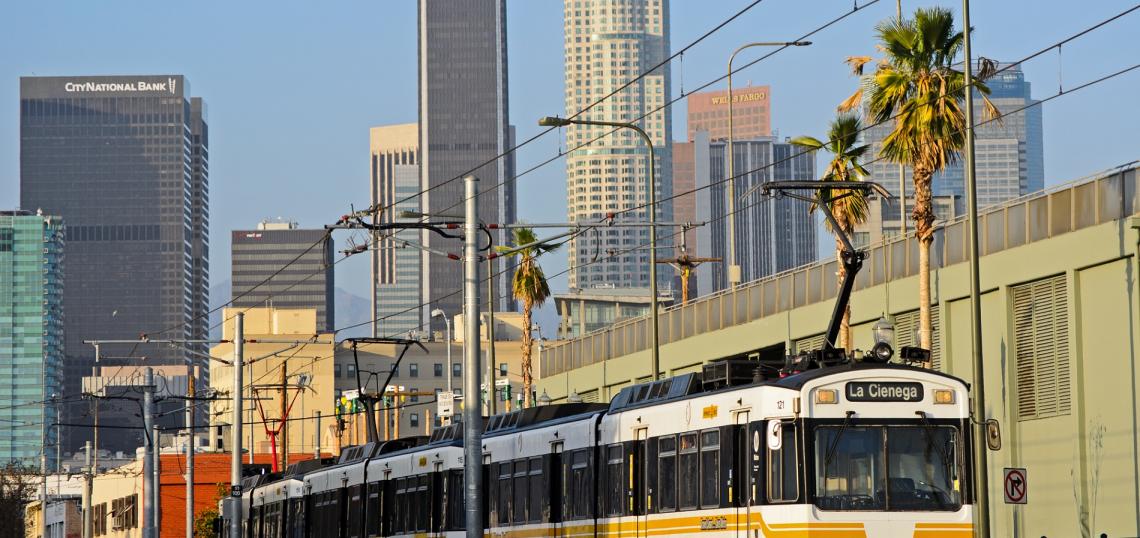The Expo Line ended 2016 with a major growth spurt, a bright spot for Metro in a year that saw systemwide transit ridership continue to slide. Expo, whose second phase connecting Downtown Los Angeles to Santa Monica opened at the end of May, registered an average of 54,000 weekday boardings in December. That figure was nearly 14% higher than November’s daily average and marked the light rail line’s second consecutive month of double digit growth.
The gains tracked the addition of all-day six-minute service, which Metro initiated in mid-October in response to concerns regarding crowdedness on the line. That service was subsequently pared back in December, when Metro restored midday service to its previous 12-minute frequencies. Month-to-month ridership can be volatile, and it remains to be seen if growth will continue into the new year. However, the gains are hopefully a sign of good things to come from the line as travel demand along the corridor matures. Expo was expected to have 64,000 daily boardings by 2030, but it seems distinctly possible that it will be closing in on that milestone by its first birthday.
One of the most impressive features of the Expo Line has been its ability to draw weekend passengers. During the second half of 2016, Expo’s weekend ridership average was over 75% of its weekday average. By contrast, during the same period, Metro’s overall rail network achieved 64% of average weekday ridership on Saturdays, and 53% of weekday ridership on Sundays.
Expo’s early successes have come with their share of growing pains. The line opened without a full complement of rail cars due to multiple delays in the acquisition process dating back to the passage of Measure R in 2008. Metro has hurriedly been entering new vehicles into service as it receives them, so that the agency can continue to expand capacity.
Issues related to street-running operations have intermittently caused delays that reverberate up and down the Blue and Expo Lines. Train congestion also seems to be a recurring issue in the Flower Street tunnel, which serves as a bottleneck for trains changing track and direction. This is occasionally compounded by trains missing their signal window at the light at 12th Street, an area of focus for Seleta Reynolds’ Department of Transportation. The Regional Connector will help improve the capacity of the tunnel, and allow for at least nominally reduced headways beginning in 2021.
Even with the operational constraint of terminating at 7th street/Metro Center removed, it may remain difficult for the Expo Line to keep its posted schedule. Street-running trains can be thrown off schedule by factors beyond the operator’s control, including car accidents in which the rail line is not directly involved. Expo trains headed to DTLA are even more sensitive to road conditions, as they must wait for inbound and outbound Blue Line trains at the intersection of Flower and Washington.
On-time performance is crucially important to rider satisfaction. Riders base their connections on expected travel time, and like being able to count on how long it will take them to get home, to work, or wherever they need to be. Transit riders really do not like encountering delays while aboard their train. Improving the reliability of a popular line should be of the utmost importance for Metro and LADOT, or it might struggle to retain its popularity.
On gamedays this fall, NFL fans swamped the Expo/USC and Expo/Vermont stations, exceeding the MTA’s expectations significantly. Even with the Expo Line running every 6 minutes, KPCC’s Meghan McCarty reported that some attendees found themselves waiting over an hour to catch a train home. While the Rams will only be playing at the Coliseum for a few more years, Expo will likely continue to see sudden spikes in demand surrounding special events. The site of the former Sports Arena will soon host the Los Angeles Football Club of Major League Soccer, while a short distance away, George Lucas’s Museum of Narrative Art will open on Vermont. Expo will be the primary Metro connection for spectators to get to the finish line of the LA Marathon in Santa Monica, as well as for fans of USC football. It’s a great thing for Los Angeles that people are patronizing events like these by transit, and it will be interesting to watch how Metro attempts to manage surges in demand on Expo going forward.
Overall, there are clearly good things to be said about Expo. It has exceeded expectations, and it is only beginning to scratch the surface of its potential regional utility. With the most recent month’s data, it became the second most popular light rail line in the network, eclipsing the Gold Line despite being just half its length. It also exceeded the Blue Line in ridership per mile during the month, becoming Metro’s highest performing light rail line by that metric, at least temporarily. Hundreds of millions of Measure M dollars are set to boost operations beginning this year, and one can only hope that Expo’s success becomes contagious.
Scott Frazier is a graduate student at Cal State University Los Angeles in Public Administration. Follow him on Twitter @safrazie.






